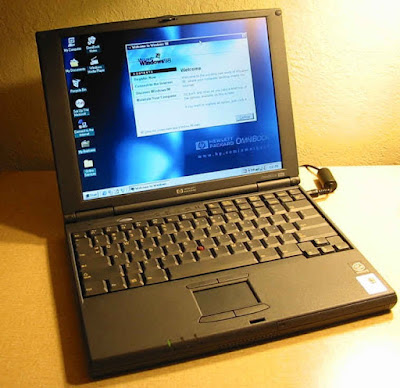© Mark Ollig
In the mid-1990s, when the internet and personal computing became a growing influence in our lives, someone began writing a column about it in their hometown newspaper.
This person was learning about home computing technology and the internet and wanted to share it in a weekly column.
Of course, I was that person who set out with an Omni notebook computer, typing away on its word processing program about my thoughts on computing and the emerging cyberspace landscape named The Internet in a column called Bits and Bytes.
In 1995, I reasoned getting a new computer and accessories would make a good story; my experience buying it would fill an entire column.
I remember walking into the computer store. The salesperson came over to me and asked, “Can I help you?”
“I’m looking for a home computer,” I replied. As the salesperson smiled, I immediately sensed he knew he would be making some serious money on this sale.
He asked how I would be using the computer, and I told him that since I would be doing a lot of writing, it needed to be installed with Microsoft Word and the Windows 95 operating system.
The computer included the MS-DOS.
I had them install 5 1/4 and 3 1/2-inch dual floppy drives on the computer, NEC MultiSync 15-inch VGA (Video Graphics Array) color monitor, IBM parallel port printer, 500 MB (megabyte) hard drive, and the Creative Labs CD-ROM with the Sound Blaster audio card.
In addition, I bought the computer with an Intel 486DX 100MHz central processing unit, which, at the time, was the latest state-of-the-art for home computing processing power.
I also needed communication software and a 28.8 kbps dial-up modem.
The salesperson asked, “Do you want an internal or external modem?”
Although I was buying a tower desktop computer, I thought it best to have an external modem, so I would not need to remove the computer housing cover to replace or set dip-switches inside the modem.
I believe the price for this 1995 computer setup was around $1,800, which, in 2022, would be about $3,350.
A home computer and processing power in the mid-1990s would be considered “Star Trek” technology compared to what powered the onboard computer guidance system of the Apollo spacecraft moon missions during the late 1960s and early ’70s.
In those days, NASA did most of the heavy computational number-crunching here on Earth, using rows of large mainframe computers with its output data relayed by satellite ground stations to the spacecraft.
In 1971, Intel built the first commercially available microprocessor chip, which sold for $60 ($420 in 2022). It was the Intel 4004 and had a clock rate of 750 kHz — thousand hertz, not mega.
The Intel 4004 was used in calculators, cash registers, and early automated teller machines.
Computer maker IBM usually comes up with challenging methods for testing their processors and software.
You might remember IBM’s supercomputer playing chess games against human chess grandmasters.
Before 1997, chess grandmasters proved the human brain superior when playing against a computer.
However, this changed in May 1997, when world chess champion Garry Kasparov competed in a six-game chess match against the $10 million IBM supercomputer named “Deep Blue.”
The computer surprisingly defeated Kasparov.
Today’s computer chess programs are not only winning because of better-written software with improved analytical processes; they also operate much faster and with greater processing power.
During the late 1990s, the story was about needing faster processing chips to calculate the algorithms for complex graphical computer gaming software programs being developed.
In the early 1970s, graphical computing games being played on our television sets included Pong.
The game console for Pong made by Magnavox was called Odyssey. Ralph Baer created it in 1969.
Some of the gaming software from the 2000s required computers equipped with what we considered a very sizable data hard drive of one or more TB (terabyte).
In 1956, the IBM 305 RAMAC (Random Access Method of Accounting and Control) data hard disk drive weighed nearly a ton and occupied 16 square feet. It stored 5MB of data on 50 24-inch-diameter disks and cost $35,000, which amounts to about $365,000 in 2022.
Today, one can purchase a Seagate Expansion 18TB external hard drive for around $500.
And to think, in 1995, a 100MB hard drive was considered a lot of data storage capacity.
If parts of today’s column seem to have been a revisit to the past, you are right; portions of its content appeared in the Aug. 7, 2002 Bits and Bytes column with some (many) corrections and updates.
